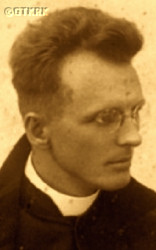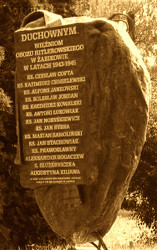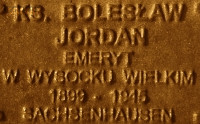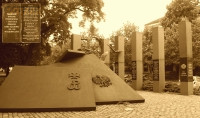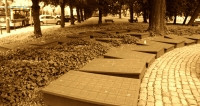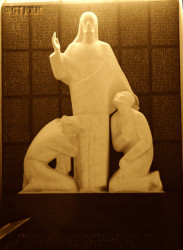Roman Catholic
St Sigismund parish
05-507 Słomczyn
85 Wiślana Str.
Konstancin deanery
Warsaw archdiocese, Poland
full list:
displayClick to display full list

searchClick to search full list by categories
wyświetlKliknij by wyświetlić pełną listę po polsku

szukajKliknij by przeszukać listę wg kategorii po polsku

Martyrology of the clergy — Poland
XX century (1914 – 1989)
personal data
surname
JORDAN
forename(s)
Boleslav (pl. Bolesław)
function
diocesan priest
creed
Latin (Roman Catholic) Church RCmore on
en.wikipedia.org
[access: 2014.09.21]
diocese / province
Gniezno and Poznań archdiocese (aeque principaliter)more on
www.archpoznan.pl
[access: 2012.11.23]
RC Military Ordinariate of Polandmore on
en.wikipedia.org
[access: 2014.12.20]
date and place
of death
21.01.1945

KL Dachauconcentration camp
today: Dachau, Upper Bavaria reg., Bavaria state, Germany
more on
en.wikipedia.org
[access: 2016.05.30]
alt. dates and places
of death
KL Sachsenhausenconcentration camp
today: Sachsenhausen‐Oranienburg, Oberhavel dist., Brandenburg state, Germany
more on
en.wikipedia.org
[access: 2018.11.18]
details of death
In 1925 prob. nominated reserve chaplain of the Polish Armed Forces (for a statutory period of two years).
After German and Russian invasion of Poland in 09.1939 and start of the World War II, after start of German occupation, went into hiding in Wysocko Wielkie (1939‐1940), Ostrów Wlkp. (1940‐1944), Pruślin (1944), Smardowice (1944), Trzemeszno (1944) where worked for an acquaintance German women — medical doctor — as a nurse.
Clandestinely continued his ministry. Celebrated Holy Mass for Poles in secret.
Began to minister as chaplain of the Polish pro–independence resistance of the Home Army AK — part of the Polish Clandenstine State — its District Command in Poznań, the capital of the German occupation province of Germ. Reichsgau Wartheland (Eng. Wartha Land), under nom‐de‐guerre „Peter”.
Finally moved to Inowrocław. From there, prob. in 05.1944, went to Poznań, where managed to get to the AL Posen‐Lenzingen penal camp and the K‐2 barracks, where the Germans held the commander of the AK Poznań District, Col. Henry Kowalówka, arrested on 22.01.1944. Prepared him for death — Col. Kowalówka was sentenced to death by the German murderous Germ. Standgericht (Eng. Summary Court) and murdered on 02.06.1944, together with 4 of his companions.
Arrested by the Germans on the train while returning to Inowrocław in 05.1944.
Held in Gniezno and Poznań prisons.
From there on 17.11.1944 transported to AL Posen‐Lenzingen penal camp.
There clandestinely ministered to the prisoners, in particular those sentenced by the Germans to death.
Finally moved to KL Sachsenhausen concentration camp.
Suffocated to death in a train car during evacuation transport from KL Sachsenhausen to KL Dachau concentration camp.
prisoner camp's numbers
20233Click to display source page (AL Posen‐LenzingenClick to display the description)
cause of death
extermination: suffocation
perpetrators
Germans
sites and events
KL DachauClick to display the description, KL SachsenhausenClick to display the description, AL Posen‐LenzingenClick to display the description, UH PosenClick to display the description, Reichsgau WarthelandClick to display the description, Ribbentrop‐MolotovClick to display the description, Pius XI's encyclicalsClick to display the description
date and place
of birth
31.03.1899

Grudziądztoday: Grudziądz city pov., Kuyavia‐Pomerania voiv., Poland
more on
en.wikipedia.org
[access: 2021.09.02]
parents
JORDAN Joseph
🞲 ?, ? — 🕆 ?, ?

KARCZMAREK Antonina
🞲 ?, ? — 🕆 ?, ?
presbyter (holy orders)
ordination
22.12.1922

Gnieznotoday: Gniezno urban gm., Gniezno pov., Greater Poland voiv., Poland
more on
en.wikipedia.org
[access: 2021.12.18]
positions held
1939 – 1940
resident — Wysocko Wielkietoday: Ostrów Wielkopolski gm., Ostrów Wielkopolski pov., Greater Poland voiv., Poland
more on
en.wikipedia.org
[access: 2021.12.18] ⋄ Exaltation of the Holy Cross RC parish ⋄ Ostrów Wielkopolskitoday: Ostrów Wielkopolski urban gm., Ostrów Wielkopolski pov., Greater Poland voiv., Poland
more on
en.wikipedia.org
[access: 2021.06.07] RC deanery — retired
1934 – 1939
administrator — Panienkatoday: Jaraczewo gm., Jarocin pov., Greater Poland voiv., Poland
more on
en.wikipedia.org
[access: 2022.02.03] ⋄ Holiest Name of Jesus RC parish ⋄ Borek Wielkopolskitoday: Borek Wielkopolski gm., Gostyń pov., Greater Poland voiv., Poland
more on
en.wikipedia.org
[access: 2021.05.06] RC deanery — comendarius
1930 – 1934
administrator — Kopanicatoday: Siedlec gm., Wolsztyn pov., Greater Poland voiv., Poland
more on
en.wikipedia.org
[access: 2022.02.03] ⋄ Blessed Virgin Mary of the Assumption RC parish ⋄ Zbąszyńtoday: Zbąszyń gm., Nowy Tomyśl pov., Greater Poland voiv., Poland
more on
en.wikipedia.org
[access: 2021.06.20] RC deanery
vicar — Pniewytoday: Pniewy gm., Szamotuły pov., Greater Poland voiv., Poland
more on
en.wikipedia.org
[access: 2021.07.18] ⋄ St Lawrence the Martyr RC parish ⋄ Lwówektoday: Lwówek gm., Nowy Tomyśl pov., Greater Poland voiv., Poland
more on
en.wikipedia.org
[access: 2020.11.27] RC deanery
1929 – 1930
vicar — Kościantoday: Kościan gm., Kościan pov., Greater Poland voiv., Poland
more on
en.wikipedia.org
[access: 2021.07.18] ⋄ Blessed Virgin Mary of the Assumption RC parish ⋄ Kościantoday: Kościan gm., Kościan pov., Greater Poland voiv., Poland
more on
en.wikipedia.org
[access: 2021.07.18] RC deanery
1929
vicar — Zbąszyńtoday: Zbąszyń gm., Nowy Tomyśl pov., Greater Poland voiv., Poland
more on
en.wikipedia.org
[access: 2021.06.20] ⋄ Blessed Virgin Mary of the Assumption RC parish ⋄ Zbąszyńtoday: Zbąszyń gm., Nowy Tomyśl pov., Greater Poland voiv., Poland
more on
en.wikipedia.org
[access: 2021.06.20] RC deanery
1925 – c. 1927
vicar — Rozdrażewtoday: Rozdrażew gm., Krotoszyn pov., Greater Poland voiv., Poland
more on
en.wikipedia.org
[access: 2021.07.18] ⋄ St John the Baptist RC parish ⋄ Koźmintoday: Koźmin Wielkopolski, Koźmin Wielkopolski gm., Krotoszyn pov., Greater Poland voiv., Poland
more on
en.wikipedia.org
[access: 2021.05.20] RC deanery
1923 – 1925
vicar — Lubasztoday: Lubasz gm., Czarnków/Trzcianka pov., Greater Poland voiv., Poland
more on
en.wikipedia.org
[access: 2021.06.20] ⋄ Nativity of the Blessed Virgin Mary RC parish ⋄ Czarnkówtoday: Czarnków gm., Czarnków/Trzcianka pov., Greater Poland voiv., Poland
more on
en.wikipedia.org
[access: 2021.06.20] RC deanery
till 1922
student — Gnieznotoday: Gniezno urban gm., Gniezno pov., Greater Poland voiv., Poland
more on
en.wikipedia.org
[access: 2021.12.18] ⋄ philosophy and theology, Archbishop's Practical Theological Seminary (Lat. Seminarium Clericorum Practicum)
from 1920
student — Poznańtoday: Poznań city pov., Greater Poland voiv., Poland
more on
en.wikipedia.org
[access: 2021.07.18] ⋄ philosophy and theology, Archbishop's Theological Seminary (Collegium Leoninum)
1919 – 1920
student — Pelplintoday: Pelplin gm., Tczew pov., Pomerania voiv., Poland
more on
en.wikipedia.org
[access: 2021.05.06] ⋄ philosophy and theology, Theological Seminary
others related
in death
ADAMCZYKClick to display biography Stanislav, BRZĄKAŁAClick to display biography Victor, BURCZYKClick to display biography Felix, BYTOFClick to display biography Peter, CHARSZEWSKIClick to display biography Paulinus Ignatius, CHYLARECKIClick to display biography Stanislav, CIEMNIAKClick to display biography Louis, CYBULSKIClick to display biography Stanislav, CZAKIClick to display biography Saturnin, CZAPIEWSKIClick to display biography Joseph Leonard, DEMSKIClick to display biography Vladislav, DOERINGClick to display biography Alexander, FIGATClick to display biography Henry, GOŃCZClick to display biography Bernard, GORALClick to display biography Vladislav, GRZEBIELEWSKIClick to display biography Joseph, GUZClick to display biography Joseph Adalbert (Fr Innocent), HEVELKEClick to display biography John, HINZClick to display biography Francis Felix, HINZClick to display biography Thaddeus, JARZĘBSKIClick to display biography Stanislav, KALINOWSKIClick to display biography Theodore, KARAMUCKIClick to display biography Edmund Leo, KARCZYŃSKIClick to display biography Cyril Methodius, KAŹMIERCZAKClick to display biography Bronislav Anthony, KLEINClick to display biography John Matthias, KOMPFClick to display biography January Sigismund, KONKOLEWSKIClick to display biography Joachim, KOWNACKIClick to display biography Bronislav, KOZUBEKClick to display biography Roman, KRAUZEClick to display biography Edmund, KRUPIŃSKIClick to display biography Louis, KUBIAKClick to display biography John (Bro. Norbert Mary), KUBICKIClick to display biography Steven Adam Marian, KUBISTAClick to display biography Stanislav, KUPILASClick to display biography Francis, LAPISClick to display biography Casimir, LENARTClick to display biography John, LICZNERSKIClick to display biography Constantine John, ŁOSIŃSKIClick to display biography Bernard Anthony, MACIĄTEKClick to display biography Stanislav Paul, MARCHLEWSKIClick to display biography Leonard, MATUSZEWSKIClick to display biography Francis Adam, MĄKOWSKIClick to display biography John, MĘŻNICKIClick to display biography Joseph, MICHNOWSKIClick to display biography Marian John, MITRĘGAClick to display biography Francis, MORKOWSKIClick to display biography Edmund, MOŚCICKIClick to display biography Joseph, NAGÓRSKIClick to display biography Paul Adalbert, NITSCHMANNClick to display biography Adam Robert, NOWAŃSKIClick to display biography Anthony, NOWICKIClick to display biography Alexander, OCHOŃSKIClick to display biography Charles Joseph (Fr Chris), OKOŁO–KUŁAKClick to display biography Anthony, PALUCHOWSKIClick to display biography Boleslav, PETRYKOWSKIClick to display biography Steven, PIASZCZYŃSKIClick to display biography Michael, PODLASZEWSKIClick to display biography Francis, POMIANOWSKIClick to display biography Vladislav, RADTKEClick to display biography Steven Boleslav, SĄSAŁAClick to display biography Theodore, SKOBLEWSKIClick to display biography Mieczyslav, SKOWRONClick to display biography Casimir, SOCHACZEWSKIClick to display biography Bronislav Peter, SWINARSKI–PORAJClick to display biography Nicholas Ignatius Bogusław, SYNOWIECClick to display biography Boleslav, SZUKALSKIClick to display biography John Wladysław, SZYMAŃSKIClick to display biography Bruno Peter John, ŚLEDZIŃSKIClick to display biography Joseph Marian, TUSZYŃSKIClick to display biography Joseph, TYMIŃSKIClick to display biography Anthony, WAWRZYNOWICZClick to display biography John, WĄSOWICZClick to display biography Sigismund, WIERZBICKIClick to display biography Sigismund Lawrence, WIERZCHOWSKIClick to display biography Fabian Sebastian, WILLIMSKYClick to display biography Albert, WŁODARCZYKClick to display biography Ignatius, WOHLFEILClick to display biography Robert, WRÓBLEWSKIClick to display biography Bronislav, ZAWISZAClick to display biography Valentine, ZIELIŃSKIClick to display biography Paul Nicholas, ZIEMSKIClick to display biography Alexander Felix, ZIENKOWSKIClick to display biography Vaclav, ŻUCHOWSKIClick to display biography Vaclav
sites and events
descriptions
KL Dachau: KL Dachau in German Bavaria, set up in 1933, became the main German Germ. Konzentrationslager (Eng. concentration camp) KL for Catholic priests and religious during World War II: On c. 09.11.1940, Reichsführer‐SS Heinrich Himmler, head of the SS, Gestapo and German police, as a result of the Vatican's intervention, decided to transfer all clergymen detained in various concentration camps to KL Dachau camp. The first major transports took place on 08.12.1940. In KL Dachau Germans held approx. 3,000 priests, including 1,800 Poles. The priests were forced to slave labor in the Germ. „Die Plantage” — the largest herb garden in Europe, managed by the genocidal SS, consisting of many greenhouses, laboratory buildings and arable land, where experiments with new natural medicines were conducted — for many hours, without breaks, without protective clothing, no food. They slaved in construction, e.g. of camp's crematorium. In the barracks ruled hunger, freezing cold in the winter and suffocating heat during the summer, especially acute in 1941‐1942. Prisoners suffered from bouts of illnesses, including tuberculosis. Many were victims of murderous „medical experiments” — in 11.1942 c. 20 were given phlegmon injections; in 07.1942 to 05.1944 c. 120 were used by for malaria experiments. More than 750 Polish clerics where murdered by the Germans, some brought to TA Hartheim euthanasia centre set up in Schloss Hartheim in Austria and murdered in gas chambers. At its peak KL Dachau concentration camps’ system had nearly 100 slave labour sub‐camps located throughout southern Germany and Austria. There were c. 32,000 documented deaths at the camp, and thousands perished without a trace. C. 10,000 of the 30,000 inmates were found sick at the time of liberation, on 29.04.1945, by the USA troops… (more on: www.kz-gedenkstaette-dachau.deClick to attempt to display webpage
[access: 2013.08.10], en.wikipedia.orgClick to attempt to display webpage
[access: 2016.05.30])
KL Sachsenhausen: In Germ. Konzentrationslager (Eng. concentration camp) KL Sachsenhausen, set up in the former Olympic village in 07.1936, hundreds of Polish priests were held in 1940, before being transported to KL Dachau. Some of them perished in KL Sachsenhausen. Murderous medical experiments on prisoners were carried out in the camp. In 1942‐1944 c. 140 prisoners slaved at manufacturing false British pounds, passports, visas, stamps and other documents. Other prisoners also had to do slave work, for Heinkel aircraft manufacturer, AEG and Siemens among others. On average c. 50,000 prisoners were held at any time. Altogether more than 200,000 inmates were in jailed in KL Sachsenhausen and its branched, out of which tens of thousands perished. Prior to Russian arrival mass evacuation was ordered by the Germans and c. 80,000 prisoners were marched west in so‐called „death marches” to other camps, i.e. KL Mauthausen‐Gusen and KL Bergen‐Belsen. The camp got liberated on 22.04.1945. After end of armed hostilities Germans set up there secret camp for German prisoners and „suspicious” Russian soldiers. (more on: en.wikipedia.orgClick to attempt to display webpage
[access: 2018.11.18])
AL Posen‐Lenzingen: German detention‐penal Germ. Arbeitserziehungslager (Eng. corrective labour camp) in Luboń‐Żabikowo — c. 10 km from Poznań city center, in Greater Poland historical region, after start of German occupation in 1939 in German province Germ. Reichsgau Wartheland — functioning from 04.1943 till 1945, taking over the role of KL Posen concentration camp. Approx. 40,000 prisoners, mainly Polish intelligentsia, members of underground clandestine independence organizations and Russian POWs, were held captive. Most of them perished in the camp (some in mass executions). (more on: pl.wikipedia.orgClick to attempt to display webpage
[access: 2014.09.21], issuu.comClick to attempt to display webpage
[access: 2013.06.23])
UH Posen: Germ. Untersuchungshaftanstalt Posen (Eng. Poznań Detention Centre), run by the Germ. Geheime Staatspolizei (Eng. Secret State Police), i.e. Gestapo, at 1 Młyńska Str. in Poznań. Death sentences by guillotine and hanging were also carried out there — in total, during World War II, the Germans are said to have murdered at least 1,639 people there (1,532 men, 93 women and 14 children — people under the age of 18), including c. 1,400 people who were probably killed by guillotine. Convicts in custody were greeted: Germ. „Wir werden auch mit dir fertig sein — Kopf herunter” (Eng. „We will finish you too — keep your head down”). Sentences were usually carried out on Tuesdays and Fridays, around on 06:00. According to the testimony of one of the German executioners: „Two assistants took the condemned by the arms and led him to a bench, where they laid him face down. The head stuck out above the bathtub. A special board pressed the condemned man's neck. At the prosecutor's call, the executioner dropped a knife weighing 2–3 hundredweight. The severed head fell into the bathtub”. (more on: pl.wikipedia.orgClick to attempt to display webpage
[access: 2013.10.05])
Reichsgau Wartheland: After the Polish defeat in the 09.1939 campaign, which was the result of the Ribbentrop‐Molotov Pact and constituted the first stage of World War II, and the beginning of German occupation in part of Poland (in the other, eastern part of Poland, the Russian occupation began), the Germans divided the occupied Polish territory into five main regions (and a few smaller). The largest one was transformed into Germ. Generalgouvernement (Eng. General Governorate), intended exclusively for Poles and Jews and constituting part of the so‐called Germ. Großdeutschland (Eng. Greater Germany). Two were added to existing German provinces. From two other separate new provinces were created. Greater Poland region was one of them, incorporated into Germany on 08.10.1939, by decree of the German leader Adolf Hitler (formally came into force on 26.10.1939), and on 24.01.1940 transformed into the Germ. Reichsgau Wartheland province, in which the law of the German state was to apply. The main axis of the policy of the new province, the territory of which the Germans recognized as the Germ. „Ursprünglich Deutsche” (Eng. „natively German”), despite the fact that 90% of its inhabitants were Poles, was Germ. „Entpolonisierung” (Eng. „Depolonisation”), i.e. forced Germanization. C. 100,000 Poles were murdered as part of the Germ. „Intelligenzaktion”, i.e. extermination of Polish intelligentsia and ruling classes. C. 630,000 were forcibly resettled to the Germ. Generalgouvernement, and their place taken by the Germans brought from other areas occupied by Germany (e.g. the Baltic countries, Bessarabia, Bukovina, etc.). Poles were forced to sign the German nationality list, the Germ. Deutsche Volksliste DVL. As part of the policy of „Ohne Gott, ohne Religion, ohne Priesters und Sakramenten” (Eng. „No God, no religion, no priest or sacrament”) most Catholic priests were arrested and sent to concentration camps. All schools teaching in Polish, Polish libraries, theaters and museums were closed. Polish landed estates confiscated. To further reduce the number of the Polish population, Poles were sent to forced labor deep inside Germany, and the legal age of marriage for Poles was increased (25 for women, 28 for men). The German state office, Germ. Rasse‐ und Siedlungshauptamt (Eng. Main Office of Race and Settlement) RuSHA, under the majesty of German law, abducted several thousand children who met specific racial criteria from Polish families and subjected them to forced Germanization, handing them over to German families. After the end of hostilities of World War II, the overseer of this province, the Germ. Reichsstatthalter (Eng. Reich Governor) and the Germ. Gauleiter (Eng. district head) of the German National Socialist Party, Arthur Karl Greiser, was executed. (more on: en.wikipedia.orgClick to attempt to display webpage
[access: 2024.06.21])
Ribbentrop‐Molotov: Genocidal Russian‐German alliance pact between Russian leader Joseph Stalin and German leader Adolf Hitler signed on 23.08.1939 in Moscow by respective foreign ministers, Mr. Vyacheslav Molotov for Russia and Joachim von Ribbentrop for Germany. The pact sanctioned and was the direct cause of joint Russian and German invasion of Poland and the outbreak of the World War II in 09.1939. In a political sense, the pact was an attempt to restore the status quo ante before 1914, with one exception, namely the „commercial” exchange of the so‐called „Kingdom of Poland”, which in 1914 was part of the Russian Empire, fore Eastern Galicia (today's western Ukraine), in 1914 belonging to the Austro‐Hungarian Empire. Galicia, including Lviv, was to be taken over by the Russians, the „Kingdom of Poland” — under the name of the General Governorate — Germany. The resultant „war was one of the greatest calamities and dramas of humanity in history, for two atheistic and anti‐Christian ideologies — national and international socialism — rejected God and His fifth Decalogue commandment: Thou shall not kill!” (Abp Stanislav Gądecki, 01.09.2019). The decisions taken — backed up by the betrayal of the formal allies of Poland, France and Germany, which on 12.09.1939, at a joint conference in Abbeville, decided not to provide aid to attacked Poland and not to take military action against Germany (a clear breach of treaty obligations with Poland) — were on 28.09.1939 slightly altered and made more precise when a treaty on „German‐Russian boundaries and friendship” was agreed by the same murderous signatories. One of its findings was establishment of spheres of influence in Central and Eastern Europe and in consequence IV partition of Poland. In one of its secret annexes agreed, that: „the Signatories will not tolerate on its respective territories any Polish propaganda that affects the territory of the other Side. On their respective territories they will suppress all such propaganda and inform each other of the measures taken to accomplish it”. The agreements resulted in a series of meeting between two genocidal organization representing both sides — German Gestapo and Russian NKVD when coordination of efforts to exterminate Polish intelligentsia and Polish leading classes (in Germany called «Intelligenzaktion», in Russia took the form of Katyń massacres) where discussed. Resulted in deaths of hundreds of thousands of Polish intelligentsia, including thousands of priests presented here, and tens of millions of ordinary people,. The results of this Russian‐German pact lasted till 1989 and are still in evidence even today. (more on: en.wikipedia.orgClick to attempt to display webpage
[access: 2015.09.30])
Pius XI's encyclicals: Facing the creation of two totalitarian systems in Europe, which seemed to compete with each other, though there were more similarities than contradictions between them, Pope Pius XI issued in 03.1937 (within 5 days) two encyclicals. In the „Mit brennender Sorge” (Eng. „With Burning Concern”) published on 14.03.1938, condemned the national socialism prevailing in Germany. The Pope wrote: „Whoever, following the old Germanic‐pre‐Christian beliefs, puts various impersonal fate in the place of a personal God, denies the wisdom of God and Providence […], whoever exalts earthly values: race or nation, or state, or state system, representatives of state power or other fundamental values of human society, […] and makes them the highest standard of all values, including religious ones, and idolizes them, this one […] is far from true faith in God and from a worldview corresponding to such faith”. On 19.03.1937, published „Divini Redemptoris” (Eng. „Divine Redeemer”), in which criticized Russian communism, dialectical materialism and the class struggle theory. The Pope wrote: „Communism deprives man of freedom, and therefore the spiritual basis of all life norms. It deprives the human person of all his dignity and any moral support with which he could resist the onslaught of blind passions […] This is the new gospel that Bolshevik and godless communism preaches as a message of salvation and redemption of humanity”… Pius XI demanded that the established human law be subjected to the natural law of God , recommended the implementation of the ideal of a Christian state and society, and called on Catholics to resist. Two years later, National Socialist Germany and Communist Russia came together and started World War II. (more on: www.vatican.vaClick to attempt to display webpage
[access: 2023.05.28], www.vatican.vaClick to attempt to display webpage
[access: 2023.05.28])
sources
personal:
www.filipini.poznan.plClick to attempt to display webpage
[access: 2012.11.23], www.wtg-gniazdo.orgClick to attempt to display webpage
[access: 2012.11.23], issuu.comClick to attempt to display webpage
[access: 2016.05.30]
bibliographical:
„Martyrology of the Polish Roman Catholic clergy under nazi occupation in 1939‐1945”, Victor Jacewicz, John Woś, vol. I‐V, Warsaw Theological Academy, 1977‐1981
original images:
issuu.comClick to attempt to display webpage
[access: 2016.05.30], zabikowo.home.plClick to attempt to display webpage
[access: 2014.01.06]
LETTER to CUSTODIAN/ADMINISTRATOR
If you have an Email client on your communicator/computer — such as Mozilla Thunderbird, Windows Mail or Microsoft Outlook, described at WikipediaPatrz:
en.wikipedia.org, among others — try the link below, please:
LETTER to CUSTODIAN/ADMINISTRATORClick and try to call your own Email client
If however you do not run such a client or the above link is not active please send an email to the Custodian/Administrator using your account — in your customary email/correspondence engine — at the following address:

giving the following as the subject:
MARTYROLOGY: JORDAN Boleslav
To return to the biography press below:
 Click to return to biography
Click to return to biography








